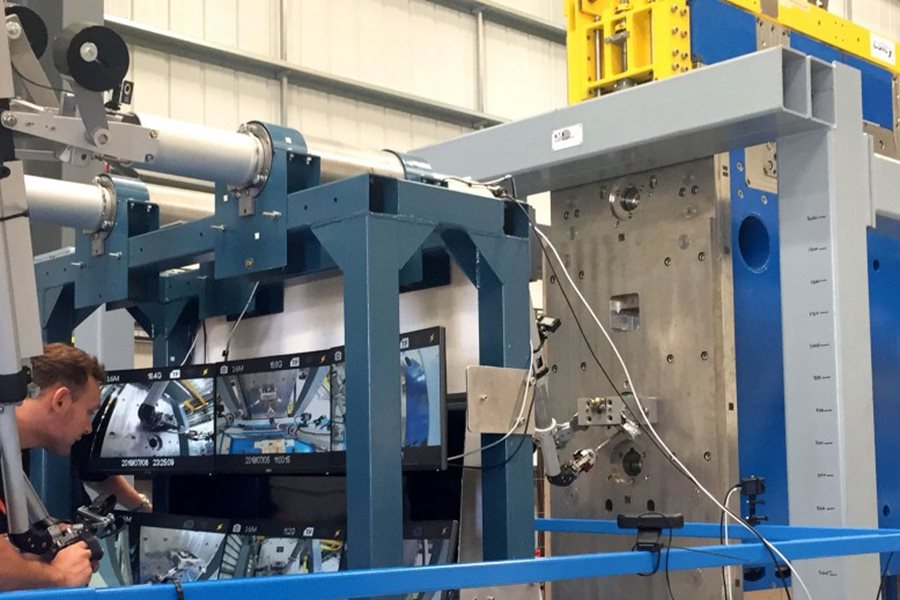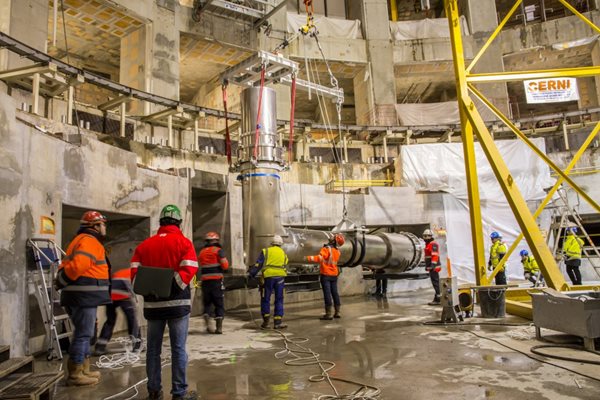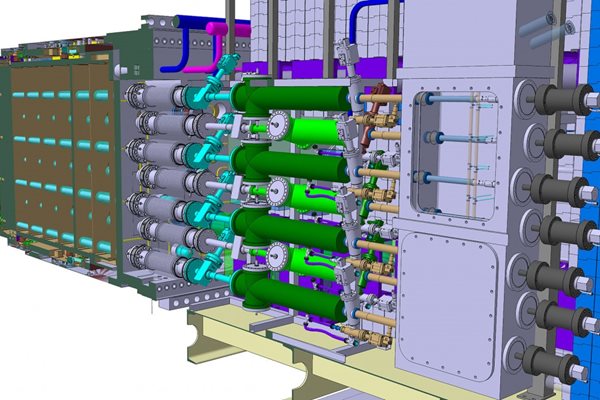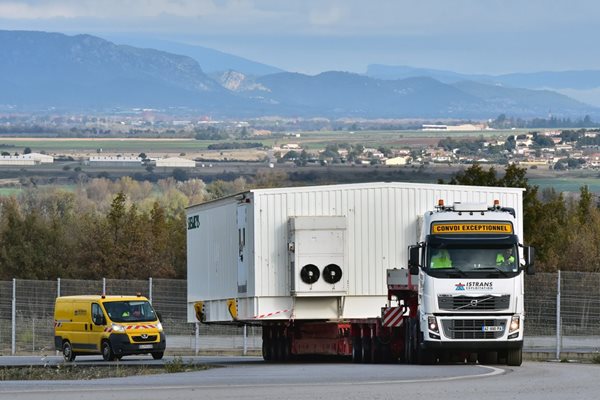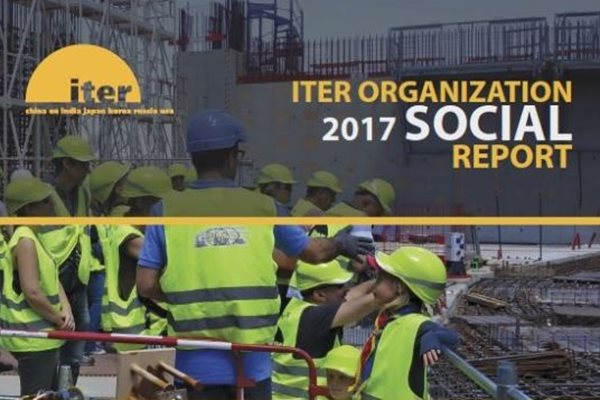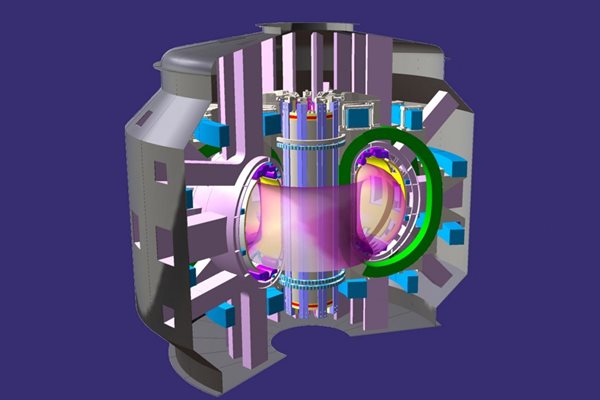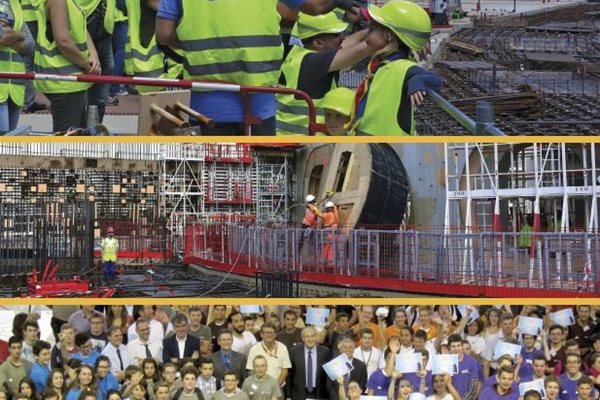
you're currently reading the news digest published from 19 Nov 2018 to 26 Nov 2018
featured5
of-interest2
publication1
press5
featured
Diagnostic port plugs | Remote handling confirmed
The ITER Organization is putting a number of its planned remote handling activities to the test in a five-year collaboration* with the UK Atomic Energy Authority's RACE facility. The first implementing agreement of the collaboration has concluded successfully. In a vast workshop in Oxfordshire, after months of fine-tuning, RACE team members successfully carried out two days of demonstrations on a mockup stand that reproduces a small part of ITER—the Hot Cell Complex assembly/disassembly zone where remote maintenance will be carried out on ITER's diagnostic port plugs. In the presence of ITER Organization witnesses from the remote handling, diagnostics and test breeding blanket sections, the team demonstrated the vertical handling of heavy loads, including removal and insertion to tight tolerances. The goal of the trials was to confirm the compatibility of system designs with planned maintenance solutions, allowing the systems to advance to final design activities and manufacturing. 'For systems requiring remote maintenance and refurbishment it is important that remote handling requirements be taken into account early in the design phase to reduce risk of costly adaptations later,' says remote handling engineer David Hamilton, who coordinates the collaboration with RACE. 'All participants—ITER Remote Handling as well as ITER system owners—are fully engaged in getting the most value and benefit out of this work.' Many of ITER's diagnostics will be mounted in the port openings of the vacuum vessel, supported within "port plugs" weighing up to 48 tonnes that can be removed from the Tokamak for maintenance. The diagnostic components will be integrated into drawer-like structures—diagnostic shielding modules—each carrying two plasma-facing walls. Once delivered to the Hot Cell Complex, the port plugs will be supported vertically while maintenance or refurbishment activities are carried out. The task at RACE focused on the insertion/removal of (mock) diagnostic shielding modules from the plug, and the insertion/removal of diagnostic first walls from the shielding modules, using a crane and manipulator arms. The stand faithfully reproduces all the 'critical' parts of the operation—the size and weight of the components, for example, and all interfacing features and tolerances as detailed by ITER Organization specifications. The demonstrations can be considered a full success. 'The trials allowed us to verify that the vertical insertion and removal operations, as planned by ITER, went smoothly, with no hang-ups or jams,' confirmed Hamilton. 'Useful suggestions were also made during the design, fabrication and operation of the test stand relating to the remote handling compatibility of the components and to planned procedures and tooling; these suggestions will be incorporated as we move forward.' Additional implementation agreements are underway relating to the remote maintenance of the vacuum vessel pressure suppression system; the feasibility of cutting and welding diagnostic first wall cooling pipes; the remote handling of vacuum flanges; synthetic viewing; test blanket module replacement, and—most recently—the maintenance of the first plasma diagnostic service modules. "Seeing these trials take place at full scale and under realistic remote handling conditions gives us real confidence in the component designs and our proposed remote handling methods." says Jim Palmer, ITER's Remote Handling Section Leader. "There comes a point in any design when paper studies can only tell you so much and the only way to fully validate a remote handling process is to really try it out." RACE also recently concluded work under a contract with the European Domestic Agency (Fusion for Energy) to test the maintenance of diagnostics inside the European diagnostic shield modules. Please see a full report here. *According to the terms of the UKAEA-ITER Organization collaboration, RACE will test and evaluate remote handling system designs, and conduct remote handling trials of generic and specific maintenance tasks in order to demonstrate the feasibility of remote handling tasks and provide operational feedback to the system designers.
A new chapter | First machine component enters the Tokamak Pit
A new chapter opened last night in the history of ITER construction as the first machine component entered the Tokamak Pit through the narrow opening in the bioshield lid. The Sun had just set on the ITER worksite when the cryostat feedthrough for poloidal field coil #4—a big, shiny stainless-steel pipe bent at a 90° angle—was slowly lifted from the Hot Cell zone to be deposited on the third level of the Tokamak Building. There, passing from one crane to another, the 10-metre, 6.6-tonne component was delicately inserted through the rectangular opening of the lid, barely large enough to allow passage, and lowered onto the floor inside the perimeter of the Tokamak crown. Since the cryostat feedthrough left the MIFI laboratory at the neighbouring CEA centre a week ago, six different lifting operations have been organized, involving four different contractors. For Patrick Petit, ITER In-Cryostat Assembly Section leader, the faultless operation carried out on 26 November 'demonstrated that we are ready to commence the assembly of the ITER Tokamak. We still have a lot of preparation work ahead of us but tonight marks the symbolic beginning of five years of intense assembly activities.' As work is being finalized in the crown opening that will accommodate it, the cryostat feedthrough will now be 'cocooned' in protective material before being moved, next week, into its final position. Newsline is planning a full report.
Plasma disruptions | A task force to face the challenge
When operating tokamaks of the size of ITER, one of the key systems to ensuring reliable and successful operation from the very first campaign onward is the disruption mitigation system. A disruption occurs when an instability grows in the tokamak plasma to the point where there is a rapid loss of the stored thermal and magnetic energy. This rapid loss can also accelerate electrons to very high energy (so-called 'runaways'). The disruption mitigation system has to protect the plasma-facing components against the heat and forces that arise during the disruption, and at the same time it must tame the runaway electrons that—if generated—could lead to melting of the first wall and leaks in the water cooling circuits. The ITER Council Science and Technology Advisory Committee (STAC) characterized disruptions at its May 2018 meeting as "a serious threat to ITER's mission." Although long recognized as a key plant system for ITER, the disruption mitigation system has proven challenging to design because of the complex physics involved in stopping runaway electrons. Experts concluded at the Disruption Mitigation Workshop hosted by the ITER Organization in 2017 that "immediate decisive action must be taken to directly support research into solutions to outstanding critical issues relating to the specification and performance of the disruption mitigation system (see the ITER Technical Report here)." To face the challenge and to ensure that the ITER system will fulfil its purpose the ITER Disruption Mitigation Task Force has been established. An extensive program has been defined that focuses on refining system design specifications and on performing engineering work for industrialization of the technology. Besides intensive work on improving the design of the selected technology for ITER, work that explores new techniques or new disruption mitigation strategies is highly encouraged. If better alternatives are available, later upgrades of the system will be possible should the present strategy fall short of ITER's needs. The international task force team is led by Michael Lehnen from ITER, who has worked in the field of disruptions for more than 10 years and coordinated the first disruption mitigation experiments at JET. The task force work is distributed over three groups. Experiments will aim on validating the ITER shattered pellet injection scheme (see more below) on today's tokamaks. The group is led by Nick Eidietis (General Atomics, USA) who is also the co-chair of the task force. He is a well-known expert in the field, coordinating the disruption mitigation work at the DIII-D tokamak. Technology, led by Uron Kruezi (ITER) and Nick Balshaw (CCFE, United Kingdom), has the focus on improving the technique itself and making it fit for the demanding environment in ITER. Theory & Modelling development is essential for the interpretation of the experiments and the extrapolation to ITER; Eric Nardon (CEA, France) and Akinobu Matsuyama (QST, Japan) will coordinate several work packages with a special eye on the physics of runaway electrons. The concept that has been chosen for the ITER disruption mitigation system is based on a technology called shattered pellet injection, a technique developed at the Oak Ridge National Laboratory and pioneered at the DIII-D tokamak. Pellets enable the injection of massive quantities of neon and deuterium into the plasma in the form of solid ice. To ensure that the plasma can assimilate these quantities, the pellets are shattered into small pieces just before they enter the vacuum vessel. The largest pellets for ITER disruption mitigation are larger than a wine cork, with a diameter of 28 mm. Despite this 'enormous' size for a cryogenic pellet, several of these have to be fired at the same time to reach the required quantities to stop the worst-case runaway electron beam in ITER. A new layout of the ITER disruption mitigation system has been proposed that allows the injection of up to 32 pellets from equatorial ports at three different toroidal locations and three pellets from different upper ports. Although the equatorial port plugs are of substantial size, the designers are challenged when it comes to integration. At its most recent meeting, the ITER Council approved the ITER Organization's strategy to tackle disruption mitigation and now the Task Force can get off the ground. To gain more confidence in whether the shattered pellet injection technique and especially the ITER disruption mitigation system design fulfils its aim, several tokamak experiments are planned and in preparation. Next year will be a productive time with more and more tokamaks joining the shattered pellet injection community. Amongst the new members are JET, where commissioning of the shattered pellet injection system has already begun, and KSTAR, where the effect of dual pellet injection in a similar configuration to that in ITER can be studied.
Cryopumps | Time to hand over to industry
After more than 12 years of development, the ITER cryopump is ready for industrial procurement. The Procurement Arrangement for the eight production torus and cryostat cryopumps was signed on 16 November 2018 between the ITER Organization and the European Domestic Agency, Fusion for Energy. As one of ITER's most complex components, and as a build-to-print procurement package, the Procurement Arrangement contains more than 500 drawings and approximately 400 pages of detailed manufacturing specifications. ITER will rely on six torus cryopumps to maintain ultra-high vacuum inside the ITER vacuum vessel during operation and to create low density—about one million times lower than the density of air. Two cryostat cryopumps will maintain the low pressure required for the operation of the superconducting magnets. According to Robert Pearce, ITER Vacuum Section leader, the design of the ITER cryopumps design has been an engineering challenge due to their operation at both cryogenic temperatures (<4.5 K) and high temperatures (up to 500 K); the precision needed on the moving parts on the world's largest all-metal high vacuum valve; and their core importance to the reliable operation of ITER. 'Not only did the pumps have to be designed, but the manufacturing of many of the parts had to be tested. The manufacturing of the pre-production cryopump (delivered to the ITER site in August 2017) paved the way for a successful final design review in March 2018.' This milestone has been achieved due to a strong collaboration between the ITER Organization and the European Domestic Agency, and has involved many actors including European industry and associations. 'Signing this Procurement Arrangement allows the call for tender to be released to manufacture the eight cryopumps,' explain the technical officers for the procurement, ITER's Matthias Dremel and Fusion for Energy's Francina Canadell. 'ITER will continue its collaboration throughout the manufacturing phase and this shall ensure delivery of the pumps to the ITER site in 2023 for installation in the divertor ports of the vacuum vessel and cryostat. These components are critical to achieving the vacuum necessary to initiate First Plasma in 2025.' Please also refer to a full report on the website of the European Domestic Agency (F4E) here. The upcoming F4E call for tender will be published on this page.
Image of the week | E-house finds a home
In February 2017, two very cumbersome loads were delivered from China to the ITER site: measuring respectively 8.3 and 8.7 metres in width, the two 'E-houses' for the steady-state electrical network came close to reaching the maximum 9-metre gauge of the ITER itinerary. On the day following the delivery, the slimmer of the two was installed in its final home between the electrical switchyard and the row of electrical transformers, while its near twin was settled into storage at the entrance of the ITER site. On 22 November, this second E-house was transported to its platform location and installed. Once fully equipped, E-houses accommodate dozens of instrumentation and control cubicles that relay orders from the control room to the installation's high voltage components.
of-interest
All about ITER staffing
You might wonder how many people are employed by the ITER Organization. Or how the staff pool breaks down in terms of hiring category, education level, gender or age. Or even something about family profile or Member representation. With 35 countries participating, "diversity" is perhaps the word that best characterizes human resources at ITER. Find out more about hiring statistics, staff metrics, mobility, training, performance and more in the ITER Organizaton 2017 Social Report. All ITER publications can be downloaded from this dedicated page on the ITER website.
Italy's new fusion test facility: calling out to industry
The Divertor Tokamak Test facility (DTT) is a new Italian fusion project that aims to address one of the major challenges identified in the European Fusion Roadmap: i.e., exhausting power from fusion reactors. The project is led by the Italian national Agency for New Technologies, Energy and Sustainable Development (ENEA) in collaboration with all the Italian fusion community and international institutions. 'DTT will mark a significant step forward for fusion development in Europe and worldwide,' stresses DTT project leader Aldo Pizzuto, 'and it will help to strengthen the industry involvement in fusion technology and engineering.' The DTT facility will be located in the ENEA premises in Frascati and the first industrial procurements for its components will be launched in early 2019. A DTT Industry Day will be held on 14 December 2018 in Frascati, which will be dedicated to the presentation of the procurement strategy and schedule. Business-to-business (B2B) meetings and bilateral thematic tables will also be organized. To register for the DTT Industry Day click here. For more information on the Divertor Tokamak Test facility, see this website.
